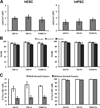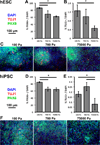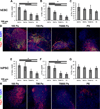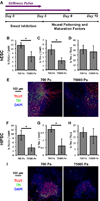Soft microenvironments promote the early neurogenic differentiation but not self-renewal of human pluripotent stem cells
- PMID: 22854634
- PMCID: PMC3459311
- DOI: 10.1039/c2ib20083j
Soft microenvironments promote the early neurogenic differentiation but not self-renewal of human pluripotent stem cells
Abstract
Human pluripotent stem cells (hPSCs) are of great interest in biology and medicine due to their ability to self-renew and differentiate into any adult or fetal cell type. Important efforts have identified biochemical factors, signaling pathways, and transcriptional networks that regulate hPSC biology. However, recent work investigating the effect of biophysical cues on mammalian cells and adult stem cells suggests that the mechanical properties of the microenvironment, such as stiffness, may also regulate hPSC behavior. While several studies have explored this mechanoregulation in mouse embryonic stem cells (mESCs), it has been challenging to extrapolate these findings and thereby explore their biomedical implications in hPSCs. For example, it remains unclear whether hPSCs can be driven down a given tissue lineage by providing tissue-mimetic stiffness cues. Here we address this open question by investigating the regulation of hPSC neurogenesis by microenvironmental stiffness. We find that increasing extracellular matrix (ECM) stiffness in vitro increases hPSC cell and colony spread area but does not alter self-renewal, in contrast to past studies with mESCs. However, softer ECMs with stiffnesses similar to that of neural tissue promote the generation of early neural ectoderm. This mechanosensitive increase in neural ectoderm requires only a short 5-day soft stiffness "pulse", which translates into downstream increases in both total neurons as well as therapeutically relevant dopaminergic neurons. These findings further highlight important differences between mESCs and hPSCs and have implications for both the design of future biomaterials as well as our understanding of early embryonic development.
Figures






Similar articles
-
Mechanobiology: a new frontier for human pluripotent stem cells.Integr Biol (Camb). 2013 Mar;5(3):450-7. doi: 10.1039/c2ib20256e. Integr Biol (Camb). 2013. PMID: 23337973 Free PMC article. Review.
-
Engineering the human pluripotent stem cell microenvironment to direct cell fate.Biotechnol Adv. 2013 Nov 15;31(7):1002-19. doi: 10.1016/j.biotechadv.2013.03.002. Epub 2013 Mar 17. Biotechnol Adv. 2013. PMID: 23510904 Free PMC article. Review.
-
Human Pluripotent Stem Cell-Derived Neurons Are Functionally Mature In Vitro and Integrate into the Mouse Striatum Following Transplantation.Mol Neurobiol. 2020 Jun;57(6):2766-2798. doi: 10.1007/s12035-020-01907-4. Epub 2020 Apr 30. Mol Neurobiol. 2020. PMID: 32356172 Free PMC article.
-
Mechanobiology of human pluripotent stem cells.Tissue Eng Part B Rev. 2013 Oct;19(5):420-30. doi: 10.1089/ten.TEB.2012.0641. Epub 2013 Apr 26. Tissue Eng Part B Rev. 2013. PMID: 23472616 Free PMC article. Review.
-
Stencil Micropatterning for Spatial Control of Human Pluripotent Stem Cell Fate Heterogeneity.Methods Mol Biol. 2016;1516:171-181. doi: 10.1007/7651_2016_325. Methods Mol Biol. 2016. PMID: 27032943
Cited by
-
Biophysical regulation of stem cell behavior within the niche.Stem Cell Res Ther. 2012 Dec 14;3(6):50. doi: 10.1186/scrt141. Stem Cell Res Ther. 2012. PMID: 23241436 Free PMC article. Review.
-
Microfluidic-Based Multi-Organ Platforms for Drug Discovery.Micromachines (Basel). 2016 Sep 8;7(9):162. doi: 10.3390/mi7090162. Micromachines (Basel). 2016. PMID: 30404334 Free PMC article. Review.
-
Induced pluripotent stem cells for regenerative medicine.Annu Rev Biomed Eng. 2014 Jul 11;16:277-94. doi: 10.1146/annurev-bioeng-071813-105108. Epub 2014 May 29. Annu Rev Biomed Eng. 2014. PMID: 24905879 Free PMC article. Review.
-
Crosstalk between Bone and Nerves within Bone.Adv Sci (Weinh). 2021 Feb 10;8(7):2003390. doi: 10.1002/advs.202003390. eCollection 2021 Apr. Adv Sci (Weinh). 2021. PMID: 33854888 Free PMC article. Review.
-
Microelastic mapping of the rat dentate gyrus.R Soc Open Sci. 2016 Apr 20;3(4):150702. doi: 10.1098/rsos.150702. eCollection 2016 Apr. R Soc Open Sci. 2016. PMID: 27152213 Free PMC article.
References
-
- Chambers SM, Fasano Ca, Papapetrou EP, Tomishima M, Sadelain M, Studer L. Highly efficient neural conversion of human ES and iPS cells by dual inhibition of SMAD signaling. Nature biotechnology. 2009;27:275–280. - PMC - PubMed
- Kriks S, Shim J-W, Piao J, Ganat YM, Wakeman DR, Xie Z, Carrillo-Reid L, Auyeung G, Antonacci C, Buch A, Yang L, Beal MF, Surmeier DJ, Kordower JH, Tabar V, Studer L. Dopamine neurons derived from human ES cells efficiently engraft in animal models of Parkinson,Äôs disease. Nature. 2011;480:547–551. - PMC - PubMed
-
- Takahashi K, Tanabe K, Ohnuki M, Narita M, Ichisaka T, Tomoda K, Yamanaka S. Induction of pluripotent stem cells from adult human fibroblasts by defined factors. Cell. 2007;131:861–872. - PubMed
- Yu J, Vodyanik Ma, Smuga-Otto K, Antosiewicz-Bourget J, Frane JL, Tian S, Nie J, Jonsdottir Ga, Ruotti V, Stewart R, Slukvin II, Thomson Ja. Induced pluripotent stem cell lines derived from human somatic cells. Science (New York, N.Y.) 2007;318:1917–1920. - PubMed
-
- Chen X, Xu H, Yuan P, Fang F, Huss M, Vega VB, Wong E, Orlov YL, Zhang W, Jiang J, Loh Y-H, Yeo HC, Yeo ZX, Narang V, Govindarajan KR, Leong B, Shahab A, Ruan Y, Bourque G, Sung W-K, Clarke ND, Wei C-L, Ng H-H. Integration of external signaling pathways with the core transcriptional network in embryonic stem cells. Cell. 2008;133:1106–1117. - PubMed
- Desbordes SC, Placantonakis DG, Ciro A, Socci ND, Lee G, Djaballah H, Studer L. High-throughput screening assay for the identification of compounds regulating self-renewal and differentiation in human embryonic stem cells. Cell stem cell. 2008;2:602–612. - PMC - PubMed
- Loh Y-H, Yang L, Yang JC, Li H, Collins JJ, Daley GQ. Genomic Approaches to Deconstruct Pluripotency. Annual review of genomics and human genetics. 2010 - PMC - PubMed
-
- Engler AJ, Sen S, Sweeney HL, Discher DE. Matrix elasticity directs stem cell lineage specification. Cell. 2006;126:677–689. - PubMed
- Fu J, Wang Y-k, Yang MT, Desai Ra, Yu X, Liu Z, Chen CS. Mechanical regulation of cell function with geometrically modulated elastomeric substrates. Nature methods. 2010;7:733–736. - PMC - PubMed
- Keung AJ, de Juan-Pardo EM, Schaffer DV, Kumar S. Rho GTPases Mediate the Mechanosensitive Lineage Commitment of Neural Stem Cells. Stem cells (Dayton, Ohio) 2011:1886–1897. - PMC - PubMed
Publication types
MeSH terms
Grants and funding
LinkOut - more resources
Full Text Sources
Other Literature Sources
Miscellaneous

